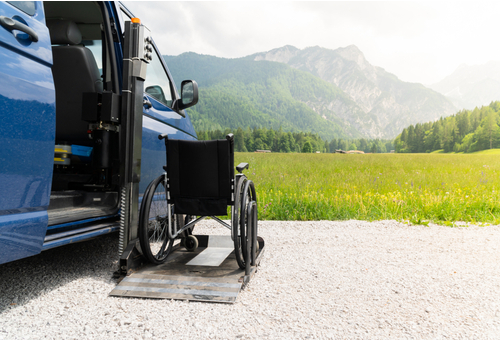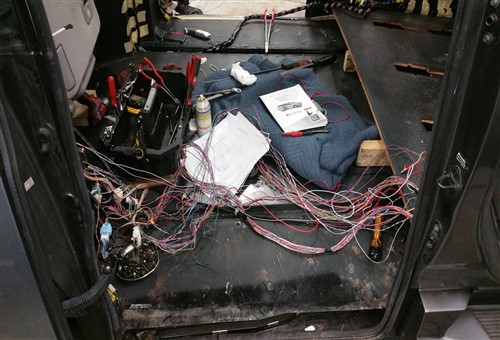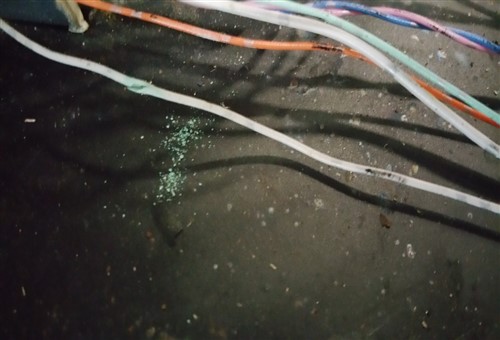
Even though the non-electricians among us don’t always realise it, we are working with electrical systems almost every day. Every time we diagnose an issue that involves a sensor, we do electrical diagnostics, simply because nothing on a modern car works without electricity.
However, diagnosing a simple wheel speed sensor is worlds apart from doing the kind of work specialist auto-electricians do. To illustrate this point, this article will recount the tale of a mechanic with limited electrical repair experience being called upon to diagnose a complex electrical fault on an imported 2013 Honda Odyssey minivan that had occurred as the result of extensive modifications to the OEM electrical system. Let us start by stating-
The customer that presented the Honda van was not exactly a stranger in our shop, but he was not exactly a regular customer, either. We had worked on all his vehicles before, but on this occasion, he arrived with a Honda Odyssey minivan we had not seen before.
In short, the problem involved the sliding door, which had been electrified by a specialised installer in the USA, to allow the original, mobility-impaired owner (now deceased) easy access to the vehicle with a wheel chair lift. The image at the top of this article is not of a Honda Odyssey, but according to the wheelchair lifts' operating instructions, the lift in the image was similar to the one that had been installed in the Odyssey.
Long story short: the current owner was not physically disabled or even impaired in any way, but he bought the vehicle with the electric sliding door as something of a vanity project. According to the van’s owner, he could not resist the temptation of being able to open the sliding door with the key fob from a distance. The only problem was, however, that the door had never worked since he bought the vehicle a few weeks before from the original owners’ estate for significantly less than its retail value.
So, since there was no point in having an electric sliding door if it didn't work, would we mind having a look to see if we could fix the door? It is perhaps worth mentioning that the wheelchair lift had been removed, and all the seats and original trim panels had been replaced by a local body repair workshop.
This should have been sufficient reason for us to decline the job, but since we weren’t as busy as usual, we agreed "to take a look". To show his appreciation for our assistance, the van's owner provided us with the wheelchair lifts’ operating manual and an invoice for the original installation. He also handed us a business card that listed the contact details of the installer in the USA. Not that we thought having the installer’s contact details would help us in any way, but we appreciated the gesture, nonetheless.
Going by appearances, the body repairer had done an excellent job. When we opened and closed the sliding door manually, we could not see evidence that the minivan had ever been fitted with a wheel chair lift. However, the invoice for the original installation identified this vehicle as having been fitted with a wheel chair lift. Thus, to see what we could learn about this particular wheel chair lift and how it worked, we consulted the operating manual to see if we could glean any useful information from it. Below are some details of-
Apart from some basic safety information, such as that the lift must only be operated when the vehicle was parked on a firm, level surface, and that the parking brake must be engaged when the lift was in operation.
It also listed some technical information, such as maximum safe working load, and the lift may not operate if the battery voltage fell below 11.5 volts. This was followed by the actual instructions in terms of which buttons on the control panel (mounted on the lift itself) performed which functions. This section concluded with the advice that the lift could be kept in peak condition by having all pivot points cleaned and lubricated twice a year.
None of this told us anything we could use, but the following section did tell us something of value, which was a description of the actual mechanics of the system. We need not delve into the finer details here, beyond saying that all moving parts were monitored and controlled by position sensors and limit switches via a dedicated control module.
Moreover, the manual also told us about several electrical interlocks that could not be bypassed without deactivating the entire system. For instance, when the lift was stowed in the vehicle, the mechanism was secured by four electronically-controlled latches, all of which had to be closed and latched before the electric sliding door could be closed with the key fob.
This section concluded that the control module that controlled the wheelchair lift had to be integrated into the vehicles' OEM electrical system by following the guidelines provided by both the manufacturer of the wheelchair lift and the vehicle's manufacturer, which brings to-
We knew that the electric sliding doors on Honda Odyssey vans were not known for their reliability, and we have reset, fixed, rebuilt, or replaced these doors many times in the past. In most cases, though, Odyssey sliding door issues can be fixed with a simple reset using the control buttons on the key fob, but this was a different scenario, altogether.
For one thing, we have never worked on an Odyssey sliding door that was wired to a wheel chair lift. Secondly, there was a good chance that the process of removing the wheelchair lift and its interlocks may have damaged the OEM electrical system. Thirdly, we had no idea how the wheelchair lifts' wiring was routed or where its control module was located, which meant that we might have to dismantle much of the vehicle's interior to trace the non-factory wiring.
Despite these issues, this writer had made an executive decision to accept the job, which was allocated to a mechanic with some experience in automotive electrics. In an ideal world, the job would have been allocated to either the diagnostician or the resident auto-electrician, but both were busy with bigger and more important jobs just then.
The hapless mechanic accepted the job with a surprising amount of grace, but he did ask one very important question as he parked the minivan in his bay, this question being-
As it turned out, we had OEM wiring diagrams for several Odyssey van models (including the 2013 model) on hand, which we had acquired from official Honda sources during previous battles with Odyssey sliding doors.
With that issue out of the way, our biggest problem was going to be figuring out how many OEM circuits were interrupted to splice the wheelchair lifts’ wiring into the OEM electrical system. For instance, we did not know how many OEM control modules were implicated in the operation of the safety interlocks that secured the lift when it was stowed.
We knew from the operating manual that the door would not work unless all four latches were closed and locked, and confirmation of their status had been acknowledged by either or both the door control module and/or one or more additional OEM control modules. If the wheelchair lift were still installed, it would have been an easy matter just to trace its wiring. However, since all outward traces of the wheel chair lift and its wiring had been removed from the vehicle, there was no telling what we would find about how the splices were made and removed.
At this point, the best way to move forward seemed to be to contact the manufacturer of the wheel chair lift to see if we could obtain a wiring diagram for it. This would tell us two things; the first would be which OEM systems were spliced into, and the second thing would (maybe) be where those splices are made. Therefore, we tasked a service advisor with finding the information.
The response we received was not encouraging. For one thing, the manufacture could not supply a wiring diagram because that particular wheel chair lift had been discontinued a few years before. However, their technical department, (who responded to our query) was kind enough to tell us that although all the wires on that model were black, they were tagged with labels that corresponded to specific wires in the OEM electrical system.
They also included instructions on how to “de-couple” the conversion side of the wiring from the OEM electrical system for diagnostic purposes. However, since the conversion side of the wiring was no longer present, there was no way to “de-couple” the two wiring systems. We were clearly on our own on this one, so to get things moving we decided to take the proverbial bull by the horns, which brings us to-
At this point, we still had no clear diagnostic strategy to work with, since we did not quite know what we were dealing with, even though the Odyssey had been in the workshop for four days.
Nonetheless, we had to start somewhere, so we decided to see if we could find the wheelchair lifts' control module. We eventually found it tucked in deep under the dashboard, but to get it out so we could do pin-out tests on it (if needed), we had to remove about 90% of the dashboard from the vehicle.
This module had two connectors; one carried 12 black wires, while the other carried 26 black wires. However, the wires on the smaller connector were all cut off flush with the back of the connector, so from a diagnostic perspective, this connector was useless.
Tracing the bundle of black wires on the other connector led us to a rubber grommet on the floor between the front seats, which suggested that we had to remove most of the seats and much of the floor behind the seats to see where the wires went on the other side of the grommet. This took up several hours, but here is what we had when we eventually had the OEM wiring exposed-

While such a tangle of wires may not present much of a problem to an expert auto-electrician, a mechanic with limited electrical experience might well be intimidated by such a sight, as the mechanic working on the problem was.
As a result, he called for guidance from the resident auto-electrician, who offered this advice-
The auto-electrician said much else besides, but he also added these additional instructions and advice-
During the post-mortem after the repair, the mechanic admitted that the job would have defeated him had the auto-electrician not clarified the problem by reducing it to its simplest form. In this case, the problem was the fact that door motor was likely not receiving a proper current, as opposed to the problem being one of having to figure out how the conversion and/or its removal affected the OEM electrical system. So here is-
A quick check showed no blown fuses, but there was no telling which relay(s) the wheelchair lift had been spliced into, or if any existing relays were implicated in the issue. Emboldened by his findings, the mechanic back probed the relevant connector, and to his surprise, he found a current of 12.3 volts with a multimeter.
Next, he applied battery power directly to the motor, which turned out to work fine. Therefore, by his reasoning, the door should work when it is plugged into the harness. However, it did not work so he called over the auto-electrician again, who verified that the door motor worked with direct battery power and that there appeared to be at least 12 volts available in the harness. The auto-electrician pondered the problem for a bit, and then asked-
The mechanic admitted that he did not know he was supposed to load the circuit. We will skip over the details of the long lecture on the relationship(s) between volts, amps, and ohms that followed, but the long and the short of is that an abnormally high resistance in the circuit could consume all, or most of the current in the circuit when the circuit has to power a load.
In this case, the load was moving the sliding door so the auto-electrician found a sealed-beam headlight that he connected to the wiring harness to simulate the load. Activating the door did cause the headlight to light up, but just barely. Testing the circuit with the barely glowing headlight attached showed that with a load, the circuit delivered only 3 volts, which was not enough to make the door motor work.
Clearly, there was an abnormal resistance in the circuit that consumed all or most of the current so the next order of business was to find the site of the problem. Here is-

Some of the OEM wiring was still encased in tape, so when the auto-electrician removed the tape, a shower of green corrosion fell out from between the wires. Also, but not shown here, some wires had overheated where they entered a splice joint connecting some black non-OEM wires to an assortment of OEM wires.
Note also the damaged insulation on some of the wires shown here. These damaged spots were all covered by electrical tape and although they showed no signs of arcing or overheating, it was obvious that long sections of the OEM wiring had to be replaced to repair the harness properly.
Further inspection revealed two more poorly executed splice joints, so the auto-electrician made up a new harness for the sliding door and repaired other wiring outside of this harness, which took up the rest of his workday. He also took it upon himself to remove all non-OEM wiring and the wheelchair lifts' dedicated control module.
All of this restored full battery power to the door motor’s harness, but there was still a problem because while the buttons on the key fob activated the sliding door, it did not open and close fully. It stopped short of both the fully open and fully closed positions. Resetting the door did not fix the problem, which suggested software or programming issues that we assumed were caused by the removal of the wheelchair lifts' wiring. Long story short; the resident diagnostician confirmed this assumption when he scanned the various serial communications systems on the van with our Honda-specific scan tool.
None of the trouble codes that appeared related to either circuit failures or circuit performance issues: all related to communication failures between control modules. By this time, however, we had had the vehicle in the workshop for seven full workdays, so we contacted the Odyssey’s owner and recommended to him that we reprogram the vehicle from scratch with all the latest updates, patches, and fixes as potentially the quickest way to fix the programming issues.
The van's owner approved the procedure that added just over $1000 to the final invoice but the extensive reprogramming fixed the door issue definitively, as expected, which leaves us with this-
All things considered, do you think getting the sliding door to work was worth our time and trouble, or the several thousand dollars the customer spent on the repair? Moreover, do you think we really needed almost 8 workdays (including time spent on programming) to fix a problem that was not even remotely as complicated as we had assumed it to be in the beginning?
Regarding the time it took to find and fix the problem, we could argue that we did not know what we were dealing with until we actually started to work on the issue. Then again, it could also be argued that if we did not grossly over think and over analysed the problem the way we did, we would have found the problem a lot sooner.
As for the just over $4000 it cost to repair the door, we can only assume that it was worth it to the customer because three years later, he still has the van and uses it as his daily driver. He is now also one of our most regular customers.
One other good thing came from this experience, though. Two weeks after this episode, the mechanic that did most of the work on the Odyssey’s sliding door enrolled in a two-year (after-hours) course at a local community college to study automotive electrics.
He passed the course near the top of his class and he is now our second resident auto-electrician, with, it must be said, hard-won experience of Honda Odyssey power sliding doors.